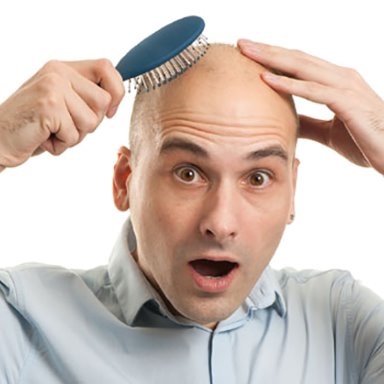
News

The bald truth about Jewish men’s obsession with their hair
JORDAN MOSHE
From the follically challenged to the tastefully tressed, the true story of Jewish men and their hair is not to be trifled with.
While men seem to have become more concerned with the state of their hair in general, Jewish men seem particularly devoted to maintaining a particular hairstyle.
A few years back, my family gently pointed out to me that my hairline seemed to be receding “ever so slightly”. This is an unwelcome reality for a male of any age, but it is particularly unnerving when you’re only 20.
Glances in the mirror became appointments with my reflection, involving copious flattening of my fringe to conceal the swathes of growing forehead. Fortunately, the receding has since stopped, and I make the most of what remains (though my family often thinks differently).
Let’s be honest, there are few things more terrifying than a bad haircut. We all seem to accept the possibility that our doctors, dentists, and plastic surgeons may botch a procedure, and sign away the right to lodge complaints. Considering how strongly we feel about the appearance of our hair, it’s a wonder hair stylists and barbers have not yet implemented the signing of indemnity agreements before agreeing to snip off a lock of someone precious hair.
I have witnessed a Jewish man throw a temper tantrum over the cut he received while in the chair of a barber. I don’t believe there was much hair on his scalp to begin with, but when he launched himself from the chair beside me, cast off the apron, and yelled about his hair being “all gone”, it was clear he felt differently.
Sometimes I think that women, for all their complaints about the endless hours of toil required to perfect their hairstyles, have it relatively easy. Even those who sport hats or sheitls have an unfair advantage over men.
Whether a woman’s hair is immaculate, slightly windswept, or even resembles a bird’s nest, they are safe from even remotely critical comments. No one would dare say anything to a member of the fairer sex about the state of their hair. Instead, they may opt to praise a look as “all natural” rather than suggesting that it looks like the result of a night’s sleep involving a wrestling match with an octopus.
To be frank, men cannot make a hair piece of any kind look good, though there are innovations that allow men to affix synthetic hair to their balding heads with water-soluble glue, and hats are reasonably popular.
A toupee can be spotted miles off, and hair treatments are time-consuming and often costly. For a man to keep a hat on his head is considered less than civil, to say nothing about impractical. A bald head can also bring on quite a chill. The challenge is, as they say, real.
Therefore, it should come as no surprise that men – Jewish ones in particular – pay keen attention to their hair. Don’t be fooled by those who seem indifferent to the windswept locks on their heads. They spend hours perfecting the look, and locking every hair into its disarrayed place.
When you’re next in a shul or brocha area, look around at the various specimens of the male hair spectrum. Don’t be fooled into believing the uniformity that a sea of kippot seems to suggest.
The “Jew-fro” has always been, and probably always will be fashionable. Unlike the standard afro, the Jew-fro is famed for its unique ability to appear carelessly brushed while in fact being painstakingly arranged.
With a small kippa typically floating atop a sea of curls, this style is traditionally preferred by younger men. However, it is not uncommon to see older men who’ve been fortunate enough to keep their hair flaunting their grizzled manes.
Others who are equally gifted with longer hair may not boast curls, but devote their time to ironing flat whatever hair they can, drawing sweeping curtains around their craniums.
Often seen flattening their hair with the palms of their hands, they are frequently paranoid about exposure to water, and rely on their hair irons more than any Jewish girl preparing for that perfect Batmitzvah photo.
Then there’s the bald-spot-denial style. Often located at the centre back of the head, the ominous bald spot is considered undesirable by most, and so every effort is made to conceal it using whatever means necessary. This entails adjusting the kippa by positioning it as far back on the head as possible, or brushing locks back to appear more follically gifted.
Sadly, there are those whose hair has receded so greatly from the head’s centre that they are forced to rely on the hair on top. This hair is often left to grow a little, and is then drawn across the top from the sides or “swirled” around the top and clamped down with a large kippa to prevent any movement.
Reluctant to move more than necessary, these are the men who try to keep to their seats and avoid any extraneous movements of the head.
Whether they are blessed with some hair or no hair, there are certain men who prefer to replicate the bristles of their chins on their heads. Sometimes almost invisible, these hairs are kept extremely short, but ever-present. By some miracle, they are able to keep kippot locked in place atop the bristles.
Perhaps even more miraculous, however, is the bald-headed look. Coming in either matte or gloss, these heads fascinate young and old alike because they possess the ability to hold a kippa without slipping. Also, they are often accompanied by a full-bodied beard which completely contradicts the nakedness of the scalp above it.
The confusion I’ve seen on the faces of children fixating on a man enshrouded in his tallit, with his beard protruding from the folds of fabric while the edge slips on the bare scalp, is a sight to behold.




